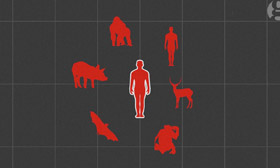We are all bleeding data. From our email addresses and tweets to our phonecalls and the items we scan at the checkout, the ever-expanding amount of information about us and the world we live in is being collected by governments, corporations and advertisers. Yet, as 140 developers, coders, designers and artists set out to prove this weekend, data – be it big or small – can also be a creative resource.
Launching on Friday evening and running for 24 hours, the first ever art hack at Tate Modern did not involve destroying the gallery's priceless collection, or illegally breaking through the firewalls of secret government databases. Instead, camped out overnight in the gallery's cavernous Turbine Hall, participants worked through the night on a single brief: "Take any form of data and transform it into a creative digital artwork."
Hack the Space was held to re-launch The Space, a platform created by the BBC and the Arts Council and first piloted in 2012 to showcase and commission digital artworks from across the worlds of art, culture and technology. The weekend doubled up as The Space's first open call for applications – it aims to commission 50 works a year from artists, known and unknown.
Chinese artist Ai Weiwei even donated some of his own data to the project – the names of the 5,196 children and young people who died in 2008's Sichuan earthquake in China, that he and thousands of bloggers collected after the Chinese government refused to release the names.
The Turbine Hall, a space that housed Ai Weiwei's own artwork Sunflower Seeds in 2010, was transformed into scenes reminiscent of a Victorian boarding house with 18 iron bunk beds lining the back walls and three long wooden tables running along its length. The illusion was only ruined by some obnoxiously bright bean-bags scattered across the floor and the Macbooks on every surface.
Ideas that began as a one-minute pitch on Friday became fully realised creative projects within 20 hours, as the hackers formed teams to pool their knowledge and resources. By Saturday evening, when the three winners were announced, 40 different projects had been created, some using Ai Weiwei's data, others mining datasets ranging from deforestation statistics to Facebook profiles. They ranged from the political to the bizarre.
One group of hackers, who titled their project Pharmaceutically Active Crustaceans, created what appeared to be a soft toy lobster that, when you hugged it, read out a sad tweet.
On the surface, a downbeat toy. Yet, for its team of four creators, a visual representation of how depositories from human antidepressants can affect wildlife. The piece engaged with three different sets of data: tweets, statistics around antidepressant use, and recent scientific findings about the emotions of crustaceans.
Tim Partridge, a co-creator, said: "We were interested in connecting the fact that pharmaceuticals, such as antidepressants, travel though our system and end up in the water system and, second, research published last week proving that crustaceans have some kind of feeling, which was previously not thought to be true. There seemed something interesting to say around how the mood-enhancing drugs we take are impacting the wider environment."

Fellow hacker Victoria Bradbury hoped the lobster might allow people to engage with data in a more emotive way. Anyone who hugged it was read genuine tweets such as "Can you be less depressed simply by forcing yourself to ruminate less about your concerns?" sent by a Danish tweeter or "I miss you and I'm afraid to lose you", tweeted from Germany. Bradbury said: "These kinds of projects are important because we do engage with data in myriad ways but [usually] in the most mundane ways."
Innovation at the hack took many formats. Glasshouse, a team of five who were awarded third prize and £1,000 to develop the idea further, outsourced their entire project to developers around the world and in their own words "did nothing".
Tom Berman explained: "I wanted to draw on the contrast between being in the Tate, this place of very elite culture, and all the workers who do the menial jobs yet who often don't have access to this art. We outsource our food, our protection, security, all of it. We think of the west as having all the ideas. I wanted to say: no, we can outsource ourselves out of it."
Posted on freelancer.com, the Tate's brief was viewed by 1,253 people around the world, before the hacker group settled on a concept developed by Nazmul Sunray, from Bangladesh, to "design a character, based upon the data from a certain Facebook profile". Sunray was paid just £15 before his brief was posted on Twitter, linking to the Facebook profile of one of the Hack the Space organisers and inviting people to create art from it.
"We had 30 people across the world working for us," said Berman. "People from Brazil, Australia, Ghana, South Korea and Norway, all implementing the project for us, creating these characters based on Nazmul's brief. All these people volunteering their time while we're here eating free food and getting all the awards and the accolades – it's an interesting contrast!"

Data was also used to make a political statement by the team awarded second prize: Adam Williams and Robert Wallner, both 24. The pair took a speech made by Vladimir Putin 10 years ago on Iraq, translated it, and using speech synthesis, animation and projection, created a mannequin with the voice of Barack Obama to read it.
"We tried to think of diametrically opposed characters that on the face of it appear to be enemies but in reality are just the same person on opposite sides of the world," said Williams. "Putin was talking about how America went in without listening to the people or the UN, just for the sake of doing whatever they want. We read that speech and thought: well hang on a minute, that's exactly what Russia is doing now."
The challenge of crafting Ai Weiwei's powerful data set into a meaningful piece of art was taken on by many of the hackers. Stef Lewandowski's Story Jar created a website that randomly generated bedtime story suggestions, each including one of Ai Weiwei's names as a character.
The winning project, $Echo, which was awarded £4,000, used the same data to visualise attacks on people's security and web presence through a series of colours and echoes. It also used the names to give voices and identities to activists behind the anti-censorship website, Great Firewall of China.
Ruth Mackenzie, director of the London 2012 Culural Olympiad and launch director of The Space, said she had been overwhelmed by the hack's creative output over 20 hours. "This is my first hackathon so I come with a refreshing ignorance," she said. "The quality, innovation and range has been really stunning though it does feel like we've been here for about a week.
"What we are trying to do here is share the spirit of experimentation. Usually you experiment in private, but we've experimented on the internet and in this enormous room which 10,000 people have been trampling through. Tate Modern is the most popular contemporary gallery in the world and we've been on show here."
As hundreds of bleary-eyed hackers packed away their laptops and filed out of the hall, MacKenzie added: "I think people are now saying: 'We want to share the journey to discovering brilliant digital art.' This is our century – let's find the new talent."





















